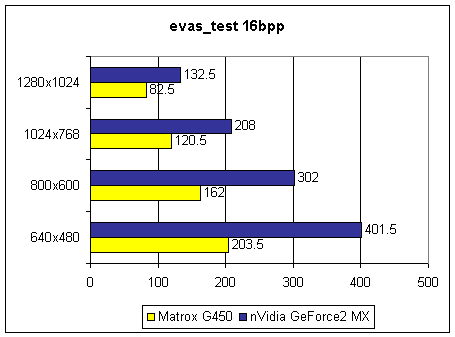Matrox Millennium G450 Under Linux
by Jeff Brubaker on September 19, 2000 12:00 PM EST- Posted in
- GPUs
3D Benchmarks
For benchmarking 3D, we included two tests that you may not know.
First, gears, which is a simple OpenGL test application that comes with Mesa. It's particularly useful given its simplicity is a good way of testing raw triangle throughput.
Second, with OpenGL acceleration becoming more and more common in Linux, developers have started taking advantage of it for more than just 3D. In particular, Rasterman, creator of the Enlightenment window manager, has written a canvas library called evas that can utilize OpenGL for image compositing and raw rendering. The result will be a window manager (Enlightenment) and file manager (EFM) that is accelerated via OpenGL. Evas comes with a test application, evas_test, that we used for benchmarking. Unlike gears, which is purely polygons and no texturing, evas_test is almost the complete opposite, stressing the texturing of the card more than raw triangle throughput.
Finally, Quake III will round out the testing.
It should be noted that the first version of Matrox's drivers (and all drivers included with all current XFree86 releases) left the card running at whatever clock speed it booted at. For the G400 and G450, that meant you were running at approximately half the speed of any Windows machine, which speeds up both the core and memory clock to production levels upon driver initialization. With the latest driver release from Matrox, this issue has been addressed. According to Matrox themselves, this happens within Hallib -- a proprietary library that may be optionally linked with the XFree86 drivers. So, it is possible that even future drivers may not set the clock to production levels accordingly unless they have specifically been linked with this library. Unfortunately, this is unlikely to be the case unless either you or your distribution has compiled it specifically themselves.

No question, the G450 is absolutely demolished. There is no texturing here, only raw triangle throughput. Although the test was run at 1280x1024, gears (by default) runs in a rather small window. We left the window size alone as it is easier to apply in comparison to other figures you may see on mailing lists, etc. Typically, this is a good measure of bus efficiency because it's definitely not fill rate limited. However, in this case, the GeForce's T&L engine keeps triangles from being sent across the bus. Score this one up to hardware superiority.

We were actually really looking forward to these benchmarks. For those users that aren't gamers, this is where they are going to get the most use out of OpenGL acceleration.
At low resolution, the NVIDIA is destroying the Matrox at almost a perfect factor of 2. However, at 1280x1024, it performs "only" 1.6 times faster than the Matrox. This here we see the fill rate/memory bandwidth limitations of the GeForce2 MX coming into play. Still, it's plenty to take care of the G450.
Also, note that this benchmark has a very low triangle count. What is important here is texturing speed, which needs memory bandwidth to achieve a proper fill rate. Matrox's G400 MAX has gobs of memory bandwidth and would probably perform well here. The G450 is similar but it's still not enough to dethrone even the GeForce2 MX.

Ok, ok. This is a "corporate" card and it's not meant for playing games. Still, makes for good comparison reading. No real surprise that the GeForce2 MX dominates once again.










0 Comments
View All Comments